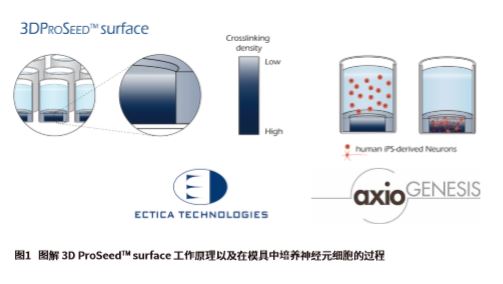Introduction
Developing more sophisticated, biologically relevant and predictive cell-based compound screening methods is a major challenge in drug discovery. The development and integration of three-dimensional (3D) analytical models is becoming more and more popular and driving the development of biotransfers. In particular, 3D cultures have the advantage of exquisitely concentrating various aspects of human tissue, including structure, cellular tissue, cell-cell and cell-matrix interactions, and more physiologically relevant feature extensions.
Hydrogels are widely used to mimic the extracellular matrix of nerve cells grown in a 3D environment. The hydrogel is a poly(ethylene glycol) (PEG)-based, fully synthetic, fully transparent material. Hydrogels help cell migration by incorporating MMP cleavage sites and contain RGD cell adhesion motifs to support cell adhesion. The fully synthetic hydrogel is pre-spread in a 96-well plate characterized by a deep density gradient that promotes three-dimensional penetration of cells on the hydrogel surface (3D ProSeedTM hydrogel, ECICA technology). This hydrogel prefabricated plate is easy to use and is also compatible with automation equipment (Figure 1).
At the same time, human-induced pluripotent stem cell (iPSC)-derived neurons are increasingly used for the development of physiological cell models; their human origin, compared to primary cell and animal models used in neuroscience applications, Longer regenerative capabilities and unlimited availability make them unique in neuroscience applications.

Forming a 3D neural network in a multiwell plate
We optimized the cell culture and staining of 96-well plates and developed a comprehensive confocal imaging and analysis method that allows neurons to be measured in a 3D model for morphological phenotype and viability. The cells used for the assay are CN.4UTM. (Axiogen AG), a human iPSC-inducing cell mix composed of neurons (glutamate, dopaminergic and GABAergic) and astrocytes. CNS.4UTM cells were incubated for 14 days in 3D ProSeedTM hydrogel (Ectica Technologies). The cells were cultured in 200 μl of medium at a density of 40,000 neurons per well. For selected studies, the effect of cell seeding density (5,000 to 8000 cells/well) was also assessed. The composition of the medium consisted of 50:50 mixed nerve basal medium + DMEM / F12 + supplement (Axiogenesis).
The cells are seeded on the surface of the hydrogel and then infiltrated into the interior of the hydrogel (Figure 1). The growth of neurites began 24 hours after planting, followed by continuous culture for more than 14 days. The formation of the neural network is monitored by transmitted light imaging. For endpoint measurements, cells were fixed with 4% formaldehyde, then permeabilized with 0.1% Triton X-100, and TUJ-1 neuron markers were stained with fluorescent antibody binding antibodies, plus Hoechst nuclear staining.
Get the full content click the button below

Our hi vis jackets come in a broad range of styles including soft shell, windbreaker, bomber jacket, parka, reversible, packable pullover, 3-season, and body warmer. These ANSI Class 2, ANSI Class 3 or Non-ANSI compliant jackets include high visibility Lime and Orange with a variety or reflective tapes for differing work environments. Silver reflective tape is a top choice for price based performance. The high contrast tape/stripe offers increased daytime visibility. Prismatic reflective tapes offer superior brightness and performance in wet weather conditions. Stay warm, dry, comfortable and safe on the job with a high visibility ANSI safety jacket.
High Visibility Jacket,High Visibility Coats & Jackets,Safety Reflective Jacket,Leather Welding Jacket
Ningbo Staneex Imp. & Exp. Co., Ltd. , https://www.staneex.com